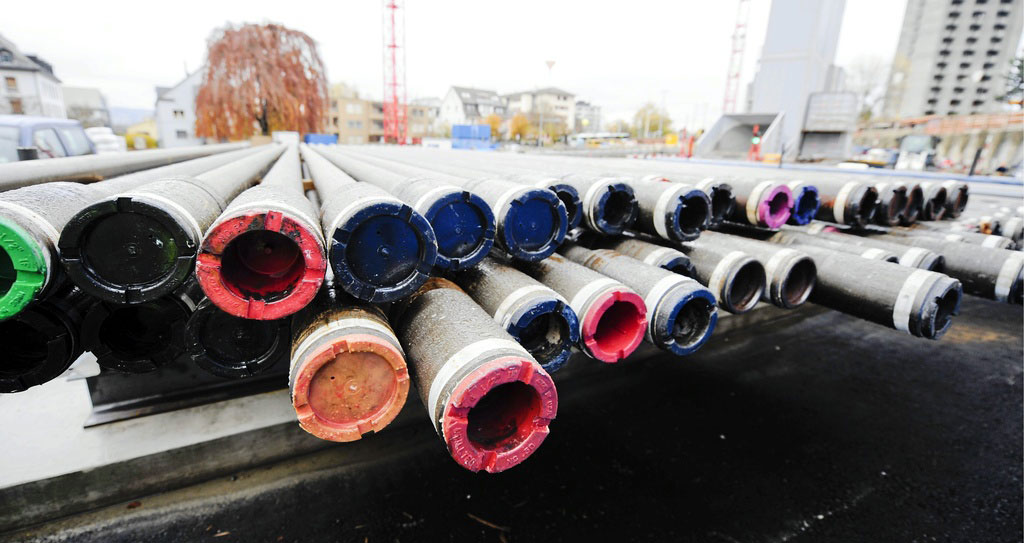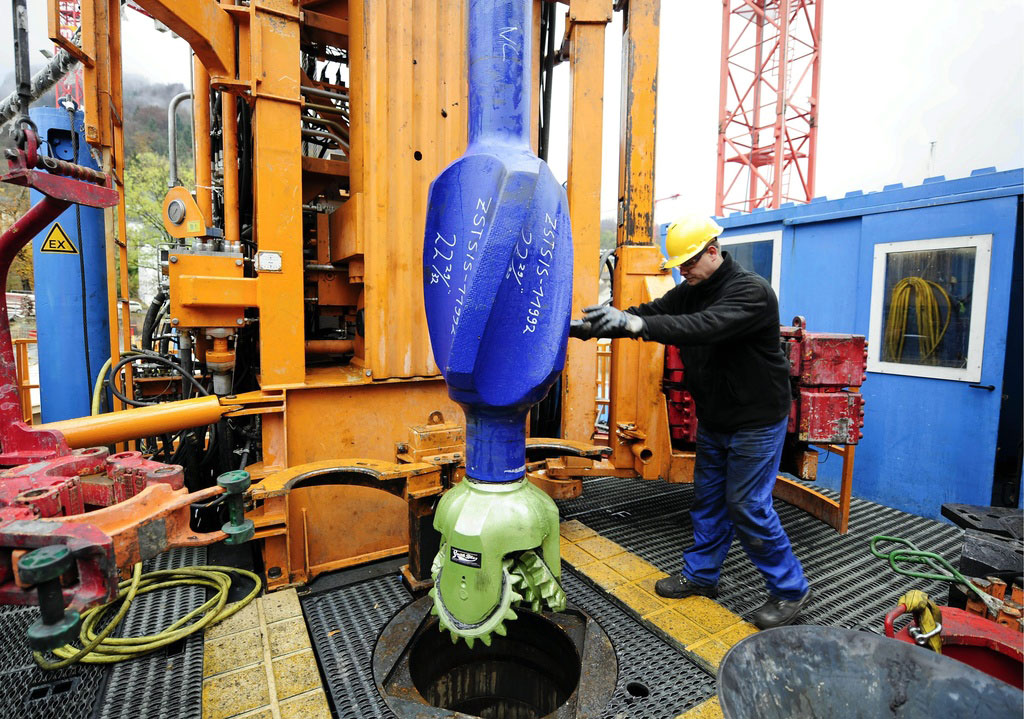Going to the depths to raise the heat

Switzerland is famous for the holes in its cheese but how many people know about the holes drilled deep below the surface of the ground?
The Swiss are keen users of geothermal energy, which can be exploited in different ways. So far, this renewable form of energy is used only for heating and hot water: power generation is a different story.
Switzerland claims a record in connection with a method that uses the natural warmth of the ground below the surface. The heat is exploited by what are known as borehole heat exchangers: Switzerland has the largest number of these anywhere in the world in proportion to its surface area.
A borehole is drilled to the required depth – up to 400 metres, but typically much less – and a U-pipe filled with water mixed with anti-freeze is inserted into it. The liquid circulates inside the pipe, drawing heat from the earth, and acts as a heat exchanger.
The method is increasingly finding favour both with families and with the owners of businesses, who can recoup their initial outlay in just a few years. It is being incorporated in many new buildings, but can be added later to older ones.
“The number of borehole heat exchangers has more than doubled over the past five years,” Daniel Pahud, head of the geothermal energy promotion centre in Ticino, told swissinfo.ch.
Figures from the Federal Energy Office show that the heat produced in this way increased by over 15 per cent from 2007 to 2008. In 2006 nearly one million metres were drilled for this purpose, according to the Swiss Society for Geothermal Energy.
Individual houses need only one borehole; office blocks and bigger buildings use several.
This is not the only way in which geothermal energy can be tapped for heating: in some areas hot underground water can be used. This is too impure to flow directly through radiators; instead pumps transfer its heat to ordinary town water.
The most important example in Switzerland is in Riehen, near Basel, where the method was first introduced in 1994. On a smaller scale, many thermal spas heat their buildings from the same source that feeds their baths. Hot water flowing from tunnels is also harnessed.
Generating power
However, the Swiss are still learning how to convert geothermal heat into electricity. There are no geothermal power stations in Switzerland, unlike Germany or Italy, which was the first country to produce electricity from beneath the ground.
“Italy is fortunate in having hot water very near the Earth’s surface, so it was not difficult to use the heat to produce electricity,” Pahud explained
“In Switzerland, there are no volcanoes, and the geological profile is different. To access exploitable heat sources, you have to go down as much as five kilometres.”
However, drilling is a tricky business, with many unpredictable factors. An innovative high-tech plant was planned at Basel as the forerunner of a series of industrial-scale electricity generating stations.
At the end of 2006, drilling triggered earth tremors, and the project was suspended. And at the end of 2009, on the basis of a thorough risk analysis, the cantonal authorities and the firm responsible for the project, Geopower SA, announced that it would be scrapped altogether.
The idea of the Deep Heat Mining project was to inject cold water to a depth of 5,000 metres, where the rock temperature is as high as 200 degrees. The superheated water would then be pumped to the surface, and used to drive turbines to generate electricity for 10,000 homes.
“The great problem is that we do not know exactly what lies beneath the surface. Some parameters can be measured, but often we have to proceed by extrapolation. That’s one of the risks of our business: success is not guaranteed,” Pahud explained.
The idea seems to be dead in Basel, but Geneva is still planning a plant on the same principle.
Untapped potential
Complex and beset with uncertainties, geothermal energy is also having difficulty in securing funding. In the contest with the sun and wind, the earth is losing out.
In 2008, the Energy Office invested around SFr1.5 million ($1.45 million) in geothermal research – 12 per cent of the Swiss Federal Energy Programme budget for renewable energies.
And yet geothermal energy has great potential: electricity can be produced without CO2 emissions and the raw material, heat, is available all the year round, regardless of atmospheric conditions.
At present, the energy obtained by exploiting geothermal heat sources accounts for less than one per cent of world production.
“It would be a great step forward if, one day, Switzerland were able to meet just three or four per cent of its energy needs from this source,” Kathy Riklin, the president of the Swiss Geothermal Society, and a member of the Swiss parliament told swissinfo.ch.
According to François-David Vuataz, head of the Neuchâtel Geothermal Research Centre, Switzerland has the necessary technical skills but lacks the resources to develop them. “We are losing the opportunity to make our mark in the renewable energies field,” he told swissinfo.ch, pointing to difficulties in capitalising on promising research.
To make up for lost ground, the research centre, in conjunction with Neuchâtel University, is offering a new master’s degree in geothermal energy. It is Europe’s first full-scale course in the field, and is expected to attract researchers from all over the continent.
Luigi Jorio and Julia Slater, swissinfo.ch
Switzerland has some 50,000 small geothermal facilities providing heat and energy to houses, apartments, offices and hotels – the highest density of geothermal installations in the world.
In 2008 total heat consumption in Switzerland was 110,000 GWh, of which 12.4 % came from renewable sources (wood, rubbish, solar, geothermal).
Geothermal sources provided 1.9% of the total; borehole heat exchangers were responsible for 1.4%.
Borehole heat exchangers use warmth at depths of up to 400m.
Other ways of using underground warmth include the installation of heat exchangers in the piles of foundations.
At a depth of 15-20m, the temperature is about 9-11 degrees; at 120-150m it is 12-15 degrees.
Riehen uses hot underground water rather than the ambient ground heat. At 1.5 km below the surface, this water is 64 degrees.
Switzerland has more than 700 road and rail tunnels. A by-product is hot water from inside the mountain which can be used for heating.
Geothermal energy is a “natural” form of nuclear energy: the result of the radioactive decay of elements present in nature, such as uranium.
In favourable geological conditions it can be used for power generation.
Prince Piero Ginori Conti tested the first geothermal generator on July 4, 1904, at the Lardello dry steam field in Italy.
The largest group of geothermal power plants in the world is located at The Geysers, a geothermal field in California, United States.
As of 2008, geothermal power supplied less than 1% of the world’s energy.
In Switzerland there are no volcanoes and the geology is extremely varied; major sources of heat lie at a depth of at least 5,000 metres.
Switzerland currently has no geothermal power plants; its first major project near Basel was suspended then scrapped after drilling triggered earth tremors in 2006.
However, Geneva is hoping to build a power plant to come into operation in 2020.

In compliance with the JTI standards
More: SWI swissinfo.ch certified by the Journalism Trust Initiative













You can find an overview of ongoing debates with our journalists here . Please join us!
If you want to start a conversation about a topic raised in this article or want to report factual errors, email us at english@swissinfo.ch.